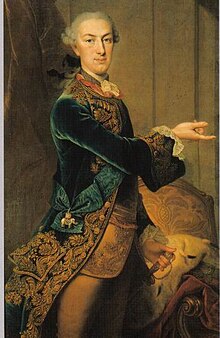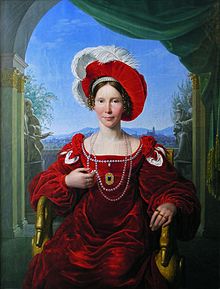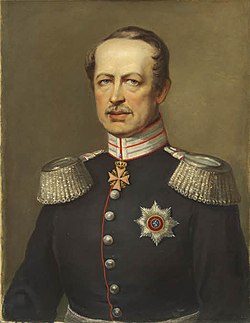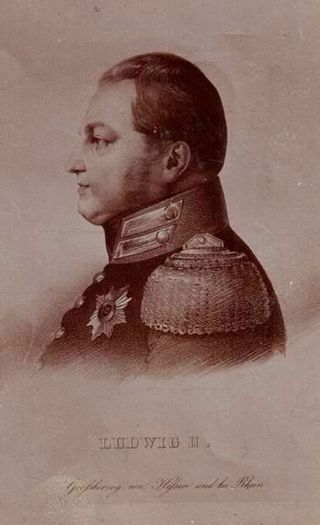(1837-1892)
Grand Duke of Hesse
1877-1892
Son of Karl von Hessen & Elisabeth von Preussen.
 |
| Alice of the United Kingdom Grand Duchess of Hesse @Wikipedia |
Husband of:
1. Alice of the United Kingdom (1843-1878), mar 1862
2. Alexandrina Hutten-Czapska (1854-1941), mar 1884, ann 1884
 |
| Alexandrine Hutten-Czapska Countess of Ramrod @esotericcuriosa |
Daughter of Count Adam Hutten-Czapsky and Countess Marianne Rzewuska
Wife of:
1. Alexander Kolemine, Russian Charge d'Affaires in Darmstadt, mar 1873, div 1884
2. Basil von Bacheracht, mar after 1884.
"This satire refers to the secret marriage of the widowed Grand Duke of Hesse, to his mistress, the divorced wife of a Russian diplomat Alexandrine von Kolemine, or Madame de Kalomine as she was known in Paris. In 1884 Queen Victoria travelled with Princess Beatrice to Darmstadt for the wedding of her grand-daughter Victoria, eldest child of the grand Duke and her deceased daughter Alice, to Louis, Prince of Battenberg. The marriage took place on 30 April in the evening; meanwhile the Grand Duke slipped away and married Madame de Kalomine in secret. The Hesse daughters liked their father’s companion, but had not envisaged a marriage. The couple, who had one son, were separated as soon as the ceremony was concluded and the marriage was annulled at Queen Victoria’s insistence; thereafter they were made to live apart, with Madame de Kalomine banned from Darmstadt." (British Museum)
"Following the death of Princess Alice in 1878, Ludwig IV contracted a morganatic marriage on 30 April 1884 in Darmstadt with Alexandrina Hutten-Czapska (3 September 1854 – 8 May 1941), the former wife of Aleksander Kolemin, the Russian chargé d'affaires in Darmstadt. His second wife received the title Countess von Ramrod. The marriage, which caused great concern within his family, was annulled within a year." (Wikipedia)
"Perhaps the briefest morganatic union of the last hundred years was that of the late Grand Duke Ludwig IV of Hesse, father of the present Grand Duke, and of the Russian Czarina. It lasted less than twenty-four hours. The woman in that case was Mme. Kolemine, now the wife of a Russian diplomat named Baron Bacherat. She was the daughter of a Russian nobleman, Count Hutten-Czapski, and when very young married Alexander Kolemine, Secretary of the Russian legation at Berne. There her beauty and her flirtations involved her husband in constant duels, and as a result he was transferred to Darmstadt. Here the Grand Duke of Hesse became one of her most enthusiastic admirers. Some years previously he had lost his wife, Princess Alice of Great Britain, and he was suffering from loneliness. Very quietly, he managed to bring about a divorce between Mme. Kolemine and her husband, and the latter’s transfer to Japan, with the rank of Russian Consul-General. The Emperor Friedrich and the Prince of Wales added their arguments to those of the Queen; and as Ludwig, despite his burly appearance, was not a man of very strong character, and as he was to a great extent dependent upon the financial assistance he and his children received from his mother-in-law, Queen Victoria, he at length gave way. Before daybreak, Mme. Kolemine was expelled from Hesse by the police, and a few weeks afterward the marriage was annulled, on the specious ground that the Grand Duke, as an officer in the German army, had neglected to obtain the necessary sanction from the Generalissimo of the army, the late Emperor Wilhelm. Opposition on the part of Mme. Kolemine was silenced by a grant of an allowance of forty thousand marks a year, and the title of Countess von Romrod. Although rumored at the time, but unsupported, before the end of the year she gave birth to a son, of whom the late Grand Duke was the father. This son was brought up in Russia by his half sister, the Czarina, and is now an officer of the Russian army." (Esoteric Curiosa)
"The Supreme Tribunal of Darmstadt confirmed the petition of the Grand Duke of Darmstadt for dissolving his marriage with his morganatic wife Countess Alexandrina von Hutten-Czapska (Madame de Kolomine). The marriage certificate, dated July 9, 1884, was admitted to be valid; the plea of divorce was supported by the hostile attitude of the petitioner's family and nearest relations; the excitement and condemnatory sentiments of his own subjects; his own conviction of the impossibility of continuing the union, which he had himself dissolved two days after its conclusion; the further conviction of the respondent that under the circumstances the union could not produce happiness, and the consequent mutual consent of both parties to the divorce." (Burke. The Annual Register of World Events, Vol 126: 38)
" . . . In April 1884, one of them was married to Prince Louis of Battenberg, and another was to be married two months later to Grand Duke Sergius of Russia. Hardly were the wedding meats of the Battenberg wedding cold, when Ludwig secretly married in the palace a beautiful Mme. de Kolemine, the widow of a Russian attache, who had the reputation of being rather an adventuress. Ludwig was madly in love with her, but she warded him off until he offered marriage. Shortly after the secret ceremony Ludwig told the queen what had happened. Then there was a scene. Ludwig stuck to his bride for some time, but he was weak, and at length yielded to the pressure put upn him by his mother-in-law, and was legally separated from his wife. Then he was restored to the good graces of the queen-empress." (The Illustrated American, Vol 10)
 |
| Ernst Ludwig of Hesse @Wikipedia |
 |
| Wilhelm I of Hesse |
(1743-1821)
Elector of Hesse
1803-1821
Landgrave of Hesse-Kassel
(Wilhelm IX)
1785-1803
His lovers were:
1) Charlotte-Christine Buissine (1749-?)
Lover in 1775-1778.
Natural offspring:
a. Wilhelm, Freiherr von Heimrod (1775-1811)
b. Karl, Freiherr von Heimrod (1776-1827)
c. Friedrich, Freiherr von Heimrod (1778-1813)
 |
| Karoline von Schlotheim @Wikipedia |
2) Karoline von Schlotheim (1766–1847)
Lover in 1788-1811
Daughter of: General Heinrich Christian Wilhelm von Schlotheim & Friederike Most aus Wilhelmsthal.
" . . . His next love was Julian Albertine von Schlotheim, who added nine children to his collection of bastards. He induced the emperor to make her a countess and installed her in a palace. . . ." (Flynn. Men of Wealth: 95)
" . . . The Electorate would have been the uncleanest hell upon earth, but for Caroline von Schlotheim, Countess of Hessenstein (Doran. Monarchs Retired from Business, Vol 1: 282)
"Caroline von Schlotheim was born in 1766 who became the longtime mistress of Wilhelm I (1743–1821), elector of Hesse-Kassel. Despite their long association Caroline posed no threat to the legal position of the Electress Wilhelmine, who was the daughter of Fredrik V, King of Denmark. . . ." (Women of History)
Benefits: " . . . She was created Countess von Schlotheim (1811) and survived her royal lover for almost three decades (1821–1847). Madame von Schlotheim died (Jan 7, 1847) aged eighty." (Women of History)
Natural Offspring: " . . . Caroline bore Wilhelm ten children who were later legitimated (1800) and granted the titles of counts and countesses von Hessenheim. . . ." (Women of History)
Natural offspring:
Natural offspring:
1. Wilhelm Friedrich, Graf von Hessenstein (1789-1790)
2. Wilhelm Karl, Graf von Hessenstein (1790-1867)
3. Ferdinand, Graf von Hessenstein (1791-1794)
4. Karoline Albertine Juliane von Schlotheim, Grafin von Hessenstein (1792-1797)
5. Auguste Wilhelmine von Hessenstein (1793-1795)
6. Ludwig Karl, Graf von Hessenstein (1794-1857)
7. Friederike, Grafin von Hessenstein (1795-1855)
8. Wilhelm Ludwig, Graf von Hessenstein (1800-1836)
9. Friedrich Ludwig, Graf von Hessenstein (1803-1805)
10. Karoline, Grafin von Hessenstein (1804-1891)
3) Rosa Dorothea Ritter (1759-1833)
Freifrau von LindenthalLover in 1779-1788
Daughter of: Johann Georg and Maria Magdalena Ritter.
"Between 1779 and 1787 Rosa Dorothea Ritter was the second of the three mistresses of the Landgrave and later Elector Wilhelm IX./I. from Hessen-Kassel. He bought her an estate in Hanau and an estate in the Rheingau and had her ennobled by the emperor in Vienna. On March 17, 1783, the emperor elevated her to the nobility of the empire with the Privilegium Denominandi. The landgrave gave her the Lindenthal estate near Wiesbaden, after which she called herself Baroness von Lindenthal. . . ." (Wikipedia)
" . . . His next affair was with Rosa Wilhelmina Dorothea Ritter, educated, well born, assertive, who gave him eight children and forced him to give her an estate and a title---Frau von Lindenthal---before she incurred his displeasure by a flirtation with a subaltern. . . ." (Flynn. Men of Wealth: The Story of Twelve Significant Fortunes from the Renaissance to the Present Day: 94)
Natural offspring:
1. Wilhelm Karl, Freiherr von Haynau (1779-?)
2. Georg Wilhelm, Freiherr von Haynau (1781-?)
3. Philipp Ludwig, Freiherr von Haynau (1782-?)
4. Wilhelmine, Freiin von Haynau (1783-?)
5. Moritz, Freiherr von Haynau (1784-?)
6. Maria Sophie, Freiin von Haynau (1785-?)
7. Julius Heinrich, Freiherr von Haynau (1786-?
8. Otto, Freiherr von Haynau (1788-?)
[Ref1:Hessian Biography]
 |
| Wilhelm II of Hesse @Wikipedia |
(1777-1847)
Elector of Hesse
1821-1847
 |
| Augusta of Prussia Electress of Hesse @Wikipedia |
Husband of:
1. Augusta von Preussen (1780-1841), mar 1797
" . . . Wilhelm and Augusta were terribly mismatched and, after seventeen years together filled with verbal and physical conflicts, the couple happily started to live separately. Unfortunately for Wilhelm, however, Princess Augusta was very popular among the people and his treatment of her “shocked public sentiment” as they rallied in support of their dejected Electress. . . ." (A King's Whore @tumblr)
2. Emilie Ortlöpp (1791-1843), mar 1841
3. Caroline von Berlepsch (1820-1877), mar 1843
 |
Emilie Ortlopp Countess of Reichenbach |
His lover was:
Emilie Ortlopp, Grafin von Reichenbach (1791-1843)
Lover in 1812-1841
" . . . When William was left by his wife, Auguste, the sister of King Frederick William III because if his mistress, Emilie Ortlopp (Countess von Reichenbach from 1821 onwards and later Countess von Lessonitz), his relations with Prussia cooles. . . When his mistress was received with hostility in Kassel, he fled with her to Hanau and left the affairs of government to Elector Frederick William as co-regent." (Killy & Vierhaus. Dictionary of German Biography: 534)
" . . . He was arbitrary and avaricious like his father, and moreover shocked public sentiment by his treatment of his wife, a popular Prussian princess, and his relations with his mistress, one Emilie Ortlopp, created countess of Reichenbach, whom he loaded with wealth. . . ." (Malit)
" . . . William lived with his mistress Emilie Ortlopp, upon whom he bestowed the title of Countess Reichenbach, and had contact with his wife, a Prussian princess who enjoyed widespread popularity. Mistresses and illegitimate children were nothing new for the rulers of Hesse-Kassel, but William II was less circumspect that his predecessors, and public tolerance for marital scandals by monarchs had declined by the nineteenth century. X X X The populace's continued hatred of the Countess Reichenbach soon forced the elector to choose between his throne and his mistress, and in March 1831 he chose the latter, following her to Hanau where she had been forced to flee by riots protesting her presence in Kassel. William declared his son Frederick William to be co-ruler, but in reality the government was now in the hands of the crown prince." (Pedlow. The Survival of the Hessian Nobility, 1770-1870: 14)
"The political climate became more heated after William II became elector in 1821. The new ruler's controversial personal life and disregard of traditional privileges soon caused relations between the monarchy and the Ritterschaft to deteriorate sharply. One of his first acts as elector was to name his mistress, Emiie Ortlopp---the daughter of a Berlin goldsmith---the Countess Reichenbach, a move that displeased many members of old noble families, who were not even allowed to use the title baron. Royal mistresses were nothing new in Hesse-Kassel, but the countess soon became very unpopular because of the way in which she used her domination of the elector to gain influence over major political decisions and government appointments. She also laid claim to social preeminence in the capital, and members of the royal court and high officials were required to pay calls upon her rather than the electress, who no longer resided in Kassel. Many nobles refused to associate with the Countess Reichenbach, and a virtual court-in-exile began to form around the electress and the crown prince, who remained loyal to his mother."
"In March 1831 the elector left the capital to join his mistress in Hanau, never to return. Six months later he turned over the government to his son Frederick William without actually abdicating. . . ." (Pedlow. The Survival of the Hessian Nobility: 226)
 |
| Friedrich Wilhelm of Hesse @Wikipedia |
(1802-1875)
Elector of Hesse
1847-1866
Son of Wilhelm II von Hessen & Augusta von Preussen.
Husband of Gertrude
 |
| Gertrude Falkenstein Princess of Hanau @Wikipedia |
His lover was:
Gertrude Falkenstein (1803-1882)
Countess of Schaumburg 1831
Princess of Hanau & zu Hořowitz 1853
Daughter of Gottfried Falkenstein, a pharmacist & Marie Magdalene Schilz.
Wife of:
1. Karl Michael Lehmann (1787-1882), mar 1822
2. Friedrich Wilhelm von Hessen, mar 1831
"Friedrich Wilhelm I met Gertrude during his studies in Bonn and persuaded the lieutenant to divorce Gertrude. Lehmann then had to say goodbye to the military. The divorce of their first marriage took place as part of a default judgment by a Prussian court in Marienwerder . The date of the divorce is unknown. Karl Lehmann later married three more times." (Wikipedia)
"As had been the case with William II, Frederick William's unpopularity was increased by his personal life. His morganatic marriage to Gertrude Lehmann, nee Falkenstein, who had divorced her husband (a Prussian officer in order to be free to marry Frederick William, was looked upon with widespread disfavor both inside and outside of Hesse-Kassel." (Pedlow. The Survival of the Hessian Nobility: 15)
"Little change in ennoblement occurred under the new ruler, Frederick William (crown prince and co-regent, 1831-47; elector, 1847-66). He also made few ennoblements, and, as had been the case under his father, several of these were involved with a controversial relationship. Shortly after his morganatic marriage to the divorcee Gertrude Lehmann, he named her the Countess of Schaumburg. . . ." (Pedlow. The Survival of the Hessian Nobility: 25)
Natural offspring
" . . . All offspring of this marriage were also to bear this rank (the marriage was morganatic, so these children could not inherit the throne). In 1853 the countess and her sons by the elector were raised to princely rank under the names Princess and Princes of Hanau. In addition, her two sons by her marriage were ennobled under the name von Hertinghausen in 1835. Two years later their name was changed to von Scholley, after an old noble family that had just become extinct in the male line, and in 1847 they became barons. . . ." (Pedlow. The Survival of the Hessian Nobility: 25)
LANDGRAVES OF HESSE

(1469-1509)
Elisabeth Wallenstein (1530-?)
"In addition William had a few natural children. Most significant and favored among these was Philipp von Cornberg (1553-1616), William's son by Elisabeth Wallenstein. Philipp was ennobled by his father and became the ancestor of the current Barons von Cornberg." (Wikipedia)




No comments:
Post a Comment